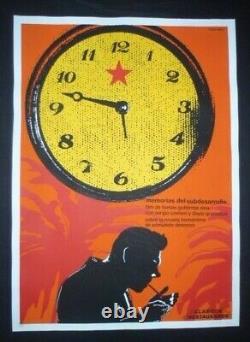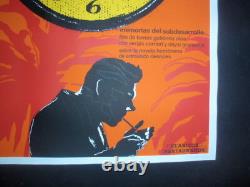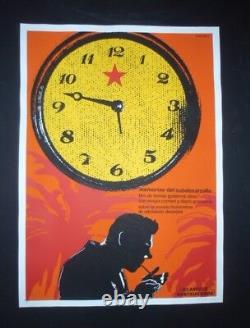MEMORIES OF UNDERDEVELOPMENT Cuban Screenprint Movie Poster for Cuba Art Project





Is offering a huge selection of handmade Cuban silk-screen movie posters, many of which work beautifully well together. To view all of the posters, please visit our.
The Cuban Poster Gallery appreciates your business! The Cuban Poster Gallery is pleased to offer. MEMORIAS DE SUBDESARROLLO (Memories of Underdevelopment). A spectacular hand-signed original limited-edition screen-printed movie poster created in 2017 for a project unveiled at the prestigious Havana film festival.
In December 2017, the Festival of New Latin American Cinema screened a number of classic Latin American films that had been expertly restored. One of the restored classics was Memories of Underdevelopment , an award-winning 1968 Cuban film directed by Tomás Gutiérrez Alea. An original limited-edition tribute poster was created for each of the restored movies shown at the festival. Only 50 copies of this hard-to-find poster were screen-printed in Havana to offer to collectors, a print run that ensures this lovely graphic will always be rare. This poster has been displayed at several exhibitions in Havana, including one at the Embassy of Spain that showcased posters from the CLASICOS RESTAURADOS (Restored Classics) series. This special poster was designed.The poster was hand-signed and -numbered by the artist. Overall condition of this 27 by 19 inch screen-print is good. As with most handmade Cuban graphics, some small imperfections can be expected. But this poster is in great shape! Brief summary of MEMORIES OF UNDERDEVELOPMENT : Sergio, a wealthy bourgeois aspiring writer, decides to stay in Cuba even though his wife and friends flee to Miami.
Sergio looks back over the changes in Cuba, from the Cuban revolution to the missile crisis, the effect of living in an underdeveloped country, and his relations with his girlfriends Elena and Hanna. Memories of Underdevelopment is a complex character study of alienation during the turmoil of social changes. The film is told in a highly subjective point of view through a fragmented narrative that resembles the way memories function. Throughout the film, Sergio narrates action, and at times is used as a tool to present bits of political information about the climate in Cuba at the time.
In several instances, real-life documentary footage of protests and political events are incorporated into the film and played over Sergio's narration to expose the audience to the reality of the revolution. Designed to salute this classic Cuban film.
DESIGNER: Fabián Muñoz Díaz b. SIGNED: Yes, by the artist's hand. NUMBERED: Yes, only 50 copies were released for sale.Approximately 27 1/2 x 19 1/2 inches. For more than 60 years, the. Cuban Film Institute has been designing silk-screened posters for most every movie shown on the island, whether the films originated in Cuba, the United States, Brazil, Japan or Italy. In the midst of the Cold War 1960s and 1970s, many of the subtitled foreign films shown in Cuba came from the island nation's communist allies in the Soviet Union, Eastern Europe, Vietnam and even North Korea. Unlike in the United States, where movie posters are often dominated by images of Hollywood stars, the Cubans assign a graphic artist to design an original piece of artwork for each film.
These posters are widely recognized in graphic design circles. As stylish works of art, handmade one color at a time and often under difficult circumstances at various times, paint and even paper have been in short supply on the island. Cuba's silk-screen movie posters are nothing less than museum pieces. But don't take our word for it!
Examples of Cuban poster art can be found in the permanent collections of museums across the globe from the Victoria & Albert in London to the Museum of Modern Art in New York, as well as in prestigious institutions such as the Library of Congress in Washington D. And the Academy of Motion Picture Arts and Sciences in Los Angeles. Adding to their collectability, Cuba's movie posters are produced in relatively small numbers. Typically, a few hundred copies are made for each film, although the runs have been as low as 50. Responding to demand from collectors, the Cuban Film Institute has re-screened some of its more popular posters.That's why some posters created in the 1960s and 1970s began reappearing on the Caribbean island in the 1990s and 2000s. Further adding to their collectability, many of Cuba's vintage posters are imperiled. To us, these survivors are rare beauties, even those with obvious flaws.
We are proud to have rescued hundreds of posters from almost certain extinction by storing them in an air conditioned, acid-free environment. We consider both to be collectible, and (in response to a question we often get) all of these posters were legally imported because the U. Government exempts artwork from its economic embargo against Cuba. While the pricier originals are favored by some collectors, the re-screens are also collectible because they were made in the same Havana workshop as the originals. Note that we never sell unauthorized reproductions that have been cranked out in print shops in the U.
